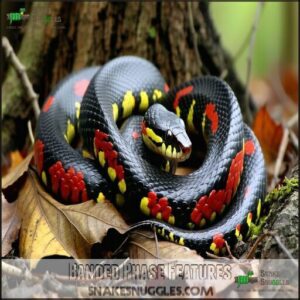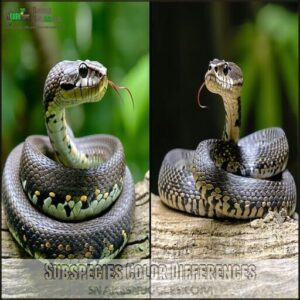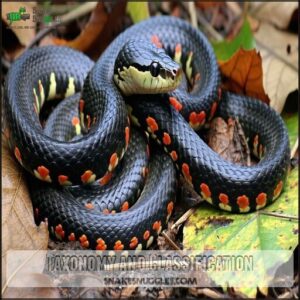This site is supported by our readers. We may earn a commission, at no cost to you, if you purchase through links.

You’ll see bold red, black, and yellow banding in some, mimicking venomous coral snakes for protection, while others display earthier tones like brown and rust for camouflage in forests.
These patterns, grouped into blotched, banded, or intermediate phases, often reflect their environment.
Eastern milk snakes lean in the direction of gray and blotched designs, while Honduran varieties flaunt bright tricolor bands.
This mimicry and variety confuse predators and also reveal evolutionary brilliance.
Curious about their subtle adjustments to blend in even more? There’s much to uncover!
Table Of Contents
- Key Takeaways
- Milk Snake Color Patterns
- Geographic Color Variations
- Subspecies Color Differences
- Mimicry and Camouflage
- Taxonomy and Classification
- Frequently Asked Questions (FAQs)
- What are the different colors of milk snakes?
- What is the red milk snake mistakenly identified as?
- Do milk snakes have morphs?
- How do captive breeding affect milk snake colors?
- Do milk snake colors change as they age?
- Can milk snakes change colors seasonally?
- Are albino milk snake variations possible?
- How do environmental factors influence coloration?
- Conclusion
Key Takeaways
- You’ll find milk snakes in two main color patterns: blotched phase (with reddish-brown markings on tan backgrounds) and banded phase (with striking red, black, and yellow rings), with some specimens displaying intermediate patterns that blend both styles.
- Milk snake colors vary geographically from Canada to Panama, with northern specimens typically showing duller colors while southern varieties display vibrant tricolor banding, and some mountain forest milk snakes even developing complete melanism (turning solid black) as adults.
- These snakes use Batesian mimicry as a survival strategy, with their red, black, and yellow banding patterns resembling venomous coral snakes, though you can distinguish them by noting that milk snakes have red bands touching black bands while coral snakes have red bands touching yellow bands.
- Despite initially being classified as 25 subspecies under Lampropeltis triangulum, genetic research in 2014 prompted taxonomists to reclassify milk snakes into 14 recognized species, though debates about their exact classification continue as DNA testing advances.
Milk Snake Color Patterns
You’ll find that milk snakes display two distinct color arrangements—the blotched phase with reddish-brown markings on tan backgrounds and the banded phase with striking red, black, and yellow rings.
These variable patterns serve as nature’s defensive strategy, allowing milk snakes to mimic venomous coral snakes while adapting to their diverse habitats across North America.
Blotched Phase Characteristics
The blotched phase of milk snakes presents a distinctive canvas of earthy elegance.
You’ll notice a brown to gray dorsum adorned with reddish-brown blotches, each precisely defined by striking black edges.
The blotch morphology creates an irregular pattern across the snake’s body, with dorsal patterns being largest along the spine.
Color intensity varies by region, with scale appearance remaining smooth regardless of pattern variations, showcasing the snake’s unique blotch morphology and overall color intensity.
Banded Phase Features
While blotched patterns feature irregular markings, the banded phase of milk snakes displays distinct, complete rings encircling the entire body.
You’ll notice these bands follow a specific ring order: typically red (or orange) rings separated from yellow (or white) rings by black bands.
The band thickness and color intensity vary between subspecies, with some showing wide red sections and others featuring narrow, vibrant bands.
Pattern stability remains consistent throughout the snake’s life, though band imperfections occasionally occur, affecting the overall pattern.
Intermediate Phase Description
Many milk snake specimens display an intermediate phase that bridges the gap between blotched and banded patterns. You’ll notice these snakes exhibit partial rings that don’t fully encircle the body, creating a transitional appearance where blotched bands and ring disruption occur simultaneously.
Milk snakes are named due to an old myth about them drinking milk from cows, though they pose no threat to livestock.
- Color intermixing often produces mottled areas where red, black, and yellow/white merge
- Pattern shifts typically appear along the snake’s flanks
- Geographic variation influences the degree of intermediate patterning
- These intermediates showcase the evolutionary spectrum of milk snake colors
Geographic Color Variations
Across the vast regions where milk snakes dwell, you’ll find remarkable geographic color variations driven by natural selection, sexual selection, and genetic drift.
These snake color patterns follow clinal variation—gradual changes across their range from Canada to Panama. You can observe how habitat influence shapes regional coloration; Canadian milksnakes typically display duller, darker brown blotches rather than vibrant bands.
Missouri variations show fascinating diversity, with northeastern specimens often exhibiting light brown blotches bordered in black, while western specimens may lack side markings between dorsal blotches. In stark contrast, Panama milksnakes develop complete melanism, turning solidly black as adults.
This geographic pattern variation isn’t random—it reflects phenotypic plasticity, allowing milk snake colors to adapt across seasons and environments. Think of it as nature’s way of fine-tuning camouflage and warning signals across different ecological contexts.
Like some milk snakes, Florida rat snakes also exhibit diverse color variations.
Subspecies Color Differences
You’ll notice dramatic differences among milk snake subspecies, from the Eastern milk snake‘s tan ground color with reddish-brown blotches to the Honduran’s vibrant orange-red bands with contrasting black borders.
Mountain forest milk snakes of Panama and Costa Rica exhibit perhaps the most striking transformation, gradually losing their juvenile banding pattern until they develop an entirely black coloration as adults, showcasing a notable example of dramatic differences and striking transformation in their appearance.
Eastern Milksnake Coloration
The Eastern Milksnake displays a distinctive coloration that sets it apart from other subspecies.
You’ll find its tan or gray ground color adorned with reddish-brown, black-edged dorsal blotches creating a stunning visual display.
Milk snakes are often mistaken for coral snakes due to their similar patterns.
- Blotch Morphology features largest markings along the center row, alternating with smaller lateral blotches
- Belly Patterns present a checkerboard effect with contrasting whitish background and squarish black blotches
- Head Markings typically form characteristic Y- or V-shaped marks at the rear
- Scale Color varies from light tan to grayish hues across its range
- Regional Hues in northeastern Missouri specimens sometimes exhibit light brown blotches bordered in black
Honduran Milk Snake Colors
Unlike their eastern cousins, Honduran milk snakes display striking color intensity with bright red base adorned by narrow yellow-white bands sandwiched between thicker black bands.
You’ll notice their distinctive black head features bold yellow-white bands behind the eyes.
In captivity, breeders have developed fascinating morphs including albinos with brilliant whites and oranges, anerythristic specimens lacking red pigmentation, and snow variants with unique pattern aberrations.
These milk snake color variations represent nature’s deceptive warning system.
Many owners purchase specialized care items for their snakes, which is a key part of their specialized care.
Mountain Forest Milk Snake Patterns
While Honduran milk snakes dazzle with vibrant reds, the Mountain Forest milk snake displays more subdued elegance.
You’ll notice their background colors range from gray-beige to pinkish-brown or red, adorned with 30-47 squarish blotches bordered by thin black lines.
These mountain dwellers feature:
- A distinct black-and-white checkerboard belly pattern
- Adult coloration that darkens with age through melanistic shift
- Geographic isolation influencing their camouflage strategy
Their habitat influence creates milk snake patterns perfectly suited for mountain forests.
Mimicry and Camouflage
You’ll notice that milk snakes exhibit striking color patterns that closely resemble venomous coral snakes, a phenomenon called Batesian mimicry that evolved to deceive potential predators.
This deceptive coloration provides significant survival advantages, as predators who’ve previously encountered coral snakes will avoid anything with similar red, black, and yellow banding patterns, which is a result of this deceptive coloration and the snakes’ ability to mimic the venomous coral snakes.
Batesian Mimicry Explanation
Looking at those vibrant subspecies color differences, you’ll notice something fascinating at work in the natural world.
Batesian mimicry explains how milk snakes have evolved their distinctive patterns as deceptive signals, which is a fascinating example of color convergence.
This evolutionary strategy involves a harmless species (the milk snake) developing milk snake color variations that mimic dangerous species for predator avoidance, creating a process of mimicry evolution.
The process of mimicry evolution creates a remarkable mimicry accuracy through natural selection, where milk snake patterns have developed to mimic venomous species.
Some milk snakes exhibit Batesian mimicry of venomous coral snakes, showcasing the effectiveness of this evolutionary strategy in predator avoidance.
Coral Snake Mimicry
Now that we comprehend the concept of Batesian mimicry, you’ll notice how milk snakes masterfully impersonate coral snakes through specific color patterns.
This resemblance isn’t coincidental but a remarkable example of Batesian deception.
When comparing these species, four key differences emerge:
- Milk snakes have red bands touching black bands
- Coral snakes display red bands touching yellow bands
- Mimicry accuracy varies by region
- Color signal intensity correlates with predator density
This predator avoidance strategy explains why milk snake color variations persist across different habitats.
You can even find products inspired by mimicry online, which is a fascinating application of mimicry in design.
Evolutionary Advantages
While coral snakes advertise their venom through bright colors, milk snakes reap similar benefits without the actual danger. You’re witnessing evolution’s clever deception at work.
Milk snakes gain remarkable adaptive advantages through their mimicry. This aposematic coloration represents millions of years of snake evolution, where genetic drift shaped these deceptive patterns across diverse environments.
| Advantage | Benefit | Ecological Impact |
|---|---|---|
| Predator avoidance | Reduced attacks | Higher survival rates |
| Enhanced growth | Earlier maturity | Greater reproductive success |
| Habitat flexibility | Wider distribution | Successful colonization |
Milk snakes use disruptive patterns to break up their outline, which is a result of millions of years of evolution and genetic drift that has led to successful colonization and greater reproductive success.
Taxonomy and Classification
You’ll find milk snakes classified within the genus Lampropeltis, which currently includes 14 recognized species that were historically considered 25 subspecies until genetic research prompted reclassification in 2014.
The scientific designation Lampropeltis triangulum belongs to the family Colubridae in the order Squamata, though taxonomists continue to debate the precise number of distinct milk snake species based on ongoing genetic studies.
Genus Lampropeltis Description
While milk snakes use color to trick predators, understanding their family tree helps explain these patterns.
The genus Lampropeltis (meaning "shiny shield") encompasses the diverse Kingsnake group that includes milk snakes.
This fascinating genus features:
- 14 recognized species with remarkable color variations
- Non-venomous constrictors with smooth, glossy scales
- Mainly North American distribution
- Similar skull structure despite diverse appearances
Lampropeltis taxonomy continues to evolve as new genetic research refines our understanding of these beautiful serpents and their evolutionary history.
Further research explores milk snake classification.
Milk Snake Subspecies Overview
The genus contains 24 recognized milk snake subspecies, each exhibiting distinctive regional variations in color and pattern.
You’ll notice significant differences when comparing subspecies: Eastern milk snakes display gray bodies with reddish-brown blotches, while Honduran milk snakes showcase vibrant orange-red bands with black borders.
This remarkable genetic diversity creates challenges for milk snake identification, particularly where subspecies ranges overlap, creating hybridization potential in the wild, which is influenced by the distinctive regional variations.
Scientific Name and Family
Within the intricate world of snake taxonomy, milk snakes belong to the Genus Lampropeltis, Family Colubridae, and Order Squamata.
You’ll find these beautiful reptiles classified scientifically as Lampropeltis triangulum, though recent taxonomy debates have complicated their classification.
- Scientists recognized 25 milk snake subspecies until a 2014 genetic study
- The study proposed dividing them into seven distinct species
- Taxonomists still disagree about the current classification system
- All milk snakes share similar genetic markers despite color variations
- Snake genus classification continues to evolve as DNA testing advances
The reorganization of snake taxonomy is an ongoing process, with DNA testing playing a crucial role in understanding the relationships between different species, and recent taxonomy debates highlighting the complexities of classification.
Frequently Asked Questions (FAQs)
What are the different colors of milk snakes?
Beauty is in the eye of the beholder, especially with milk snakes.
You’ll find them in various combinations of red, black, white, yellow, orange, brown, gray, and even solid black in some mountain subspecies.
What is the red milk snake mistakenly identified as?
The red-banded milk snake is commonly mistaken for the venomous coral snake due to their similar red, black, and yellow/white banding patterns.
You’ll notice the key difference in band arrangement—coral snakes have touching red and yellow bands, which is a critical distinction to make when identifying these species.
Do milk snakes have morphs?
Like jewels in a treasure chest, milk snakes do have morphs.
You’ll find numerous variations in captive breeding, including striped, spotted, and high-contrast morphs with diverse colors beyond their typical three-color wild patterns.
How do captive breeding affect milk snake colors?
Captive breeding lets you see milk snakes in colors nature rarely offers.
Breeders create stunning morphs, like striped or high-contrast patterns, by selectively mating for unique traits, adding endless variety to these colorful snakes’ appearances, with stunning visual effects.
Do milk snake colors change as they age?
Imagine your vibrant hatchling transforming over time.
Yes, milk snake colors do change as they age.
You’ll notice some subspecies, particularly mountain forest milk snakes, dramatically darken to solid black, while others’ patterns become more defined and intense.
Can milk snakes change colors seasonally?
Milk snakes don’t change their colors seasonally.
Their color pattern remains consistent throughout the year, unlike some reptiles that adapt to environmental changes.
You’ll see the same distinctive banding regardless of season.
Are albino milk snake variations possible?
Yes, albino milk snakes are definitely possible.
You’ll find these striking morphs lack melanin, displaying vivid yellow and white coloration with red patterns.
They’re popular in the reptile hobby for their distinctive appearance.
How do environmental factors influence coloration?
Geographic location shapes your milk snake’s colors.
You’ll notice temperature affects thermoregulation patterns, while elevation and climate drive regional adaptations.
Their colors typically fade with age, creating natural variations between mountain and lowland populations, driven by regional adaptations.
Conclusion
What happens when nature plays dress-up?
You’ve now unraveled milk snake color variations explained through evolutionary marvels.
These reptiles don’t just wear their bands and blotches for show—they’re survival masterpieces refined over millennia.
Whether mimicking deadly coral snakes or blending into forest floors, each pattern tells a story of adaptation.
Next time you spot these harmless beauties, you’ll appreciate how their deceptive coloration represents one of nature’s most elegant survival strategies.












